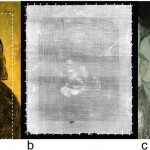 Painted around 1876, Edgar Degas’ Portrait of a Woman seemed just that — an otherwise ordinary female depiction in the artist’s moody style. But as it aged in the 1920s, people started noticing a mysterious second figure emerging from beneath the first. Curious but wishing to avoid damaging the painting, conservators used a new X-ray technique to peer beyond the top layer of paint, detailed in a new paper in Scientific Reports . This unveiled a never-before-seen portrait of a woman they believe to be frequent Degas model Emma Dobigny. Traditional X-ray scans require a heavy element like lead to absorb the radiation and provide image contrast, and provide “minimal quantitative or specific elemental identification information” the paper’s co-author Daryl Howard of Australian Syncotrain told Gizmodo . So imprecise are the results that the interpretation of X-radiography images is a highly subjective process, according to the team’s paper. Instead, they used X-ray Fluorescence (XRF) in a non-invasive method they call the Maia technique to scan Portrait of a Woman with the sensitivity to enable reconstruction of concealed paint layers. Advancements have shaved pigment analysis time down to milliseconds while dramatically improving data collection rates, meaning XRF can measure swaths of a painting at spatial resolutions the size of a single paintbrush bristle. Such sensitivity doesn’t just unearth the hidden second figure — it unveiled the painting at various stages. For instance, Degas had originally given the Dobigny figure pointed elfin ears before replacing them with ones more like the model’s own. While we don’t know why the artist had painted over one woman in favor of the other, these non-invasive techniques allow art historians to pry the creative stages apart and forensically peer below the finished work on the hunt for answers. Via: Gizmodo Source: Scientific Reports
Painted around 1876, Edgar Degas’ Portrait of a Woman seemed just that — an otherwise ordinary female depiction in the artist’s moody style. But as it aged in the 1920s, people started noticing a mysterious second figure emerging from beneath the first. Curious but wishing to avoid damaging the painting, conservators used a new X-ray technique to peer beyond the top layer of paint, detailed in a new paper in Scientific Reports . This unveiled a never-before-seen portrait of a woman they believe to be frequent Degas model Emma Dobigny. Traditional X-ray scans require a heavy element like lead to absorb the radiation and provide image contrast, and provide “minimal quantitative or specific elemental identification information” the paper’s co-author Daryl Howard of Australian Syncotrain told Gizmodo . So imprecise are the results that the interpretation of X-radiography images is a highly subjective process, according to the team’s paper. Instead, they used X-ray Fluorescence (XRF) in a non-invasive method they call the Maia technique to scan Portrait of a Woman with the sensitivity to enable reconstruction of concealed paint layers. Advancements have shaved pigment analysis time down to milliseconds while dramatically improving data collection rates, meaning XRF can measure swaths of a painting at spatial resolutions the size of a single paintbrush bristle. Such sensitivity doesn’t just unearth the hidden second figure — it unveiled the painting at various stages. For instance, Degas had originally given the Dobigny figure pointed elfin ears before replacing them with ones more like the model’s own. While we don’t know why the artist had painted over one woman in favor of the other, these non-invasive techniques allow art historians to pry the creative stages apart and forensically peer below the finished work on the hunt for answers. Via: Gizmodo Source: Scientific Reports
Read the original post:
X-ray technique unveils mystery second figure in Degas painting






